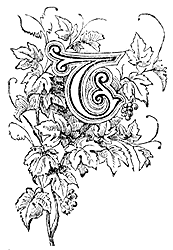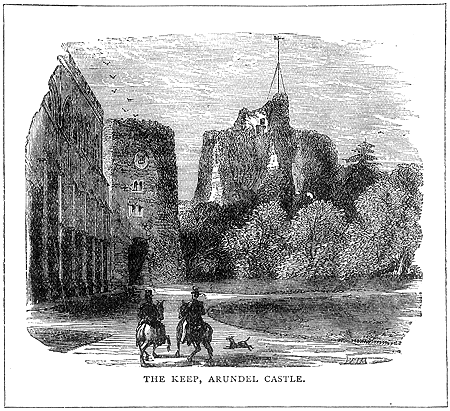 |

HIS noble and picturesque castle belongs to the Duke of Norfolk, to whom it gives the title of Earl of Arundel; the peerage being attached to the tenure of the house, so that, whoever legally possesses Arundel Castle becomes an earl without requiring any other form, patent, or creation. William the Conqueror bestowed the castle, which existed in Edward the Confessor's time, on Roger de Montgomery, one of his bravest knights, who thus became Earl of Arundel. Arundel Castle stands on a steep circular knoll, and commands a fine sea view. The entrance gate has a drawbridge and porticullis, and was originally built in the reign of Edward I. The keep and some of the walls are of the ancient castle. Taken and retaken by Parliamentarians and Cavaliers, the castle was nearly a ruin till in 1815, Charles Howard, the eleventh Duke of Norfolk, restored it at the cost of more than half a million of money.
Arundel Keep is the most perfect in England. It is a circular stone tower with a dungeon in the middle, accessible by a flight of stairs. Many owls frequent the ancient building.
A queen of England had once her home within these castle walls. Adeliza, the charming second wife and widow of Henry 1., fell in love with William de Albini, Earl of Arundel, and wedded him. That he was a peerless knight there is no doubt, for the same tradition belonged to him as to our Coeur de Lion, i.e. that he killed a lion by pulling out its tongue (Richard was said to have torn out the heart! /) but the story probably arose, Mr. Planche thought, from the Earl's assuming a golden lion in his arms when he married his royal bride.
 When the Empress Maud came to claim her father's crown from Stephen, who had usurped it, she landed at Little Hampton and proceeded to visit her step-mother at Arundel Castle. Adeliza received her cordially, but King Stephen hearing of the Empress's residence at Arundel, at once marched there and appeared before the castle with an army: demanding that Maud should be given up to him. Queen Adeliza sent him this spirited answer: "I have received the Empress as my friend, not as your enemy. I have no intention of interfering in your quarrels, and beg you to allow my royal guest to leave Arundel, and try her fortune in some other part of England. But if you are determined to besiege her here, I will endure the last extremity of war rather than give her up or suffer the laws of hospitality to be violated."
Stephen was a true knight in courtesy at least. He yielded to the demand of Queen Adeliza and permitted Maud to depart safely to Bristol.
It was at Arundel Castle that the nobles who were accused of plotting to seize the person of Richard II. and kill the Lords of his council were taken. The Earl of Arundel, on the evidence of the Earl Marshal, was executed.
Bodiam Castle is another of the fine old castles that must have so well defended the southern counties from the French, who for twenty years before it was built, had ravaged the country round Hastings and Winchelsea, and eight years before bad besieged Battle.
The castle is situated on the north bank of the Rother, and is surrounded by a perfect moat, which is crossed on the north side by a causeway on which some ruins of a barbican still remain.
The castle is nearly square with circular towers, sixty-five feet high, at the four corners, connected by embattled curtains; in the centre of each of which rise square towers equal in height to the circular. The gateway is composed of two flanking towers, in which are numerous oilettes for arrows. It has embattled parapets and deep machicolations whence stones and other missiles could be hurled on assailants Covered now with ivy, there were once three shields above the gateway, bearing the arms of the former owners of the castle. Passing through the gateway we see that there were two more further on; and that there was a balcony at the lower half of the passage. On the southern side of the quadrangle were the windows of the great hall and the still remaining windows of the buttery and kitchen. On the left of the quadrangle are a series of chambers once probably occupied by the officers of the fortress. The whole courtyard was surrounded by buildings. Next we come to the ruins of the chapel, and then to the residence of the Lord of the castle. The lady's "bower" or boudoir is the first we enter. The sleeping apartments were in the square tower or keep; in one of these rooms are two curious stone cupboards.
The castle was destroyed by the Parliamentarians under Waller, and since then the ruins have crumbled before the rain and frosts of winter, and present now a mere outline of the manner in which the feudal nobles of England lived five hundred years ago.
|
 |